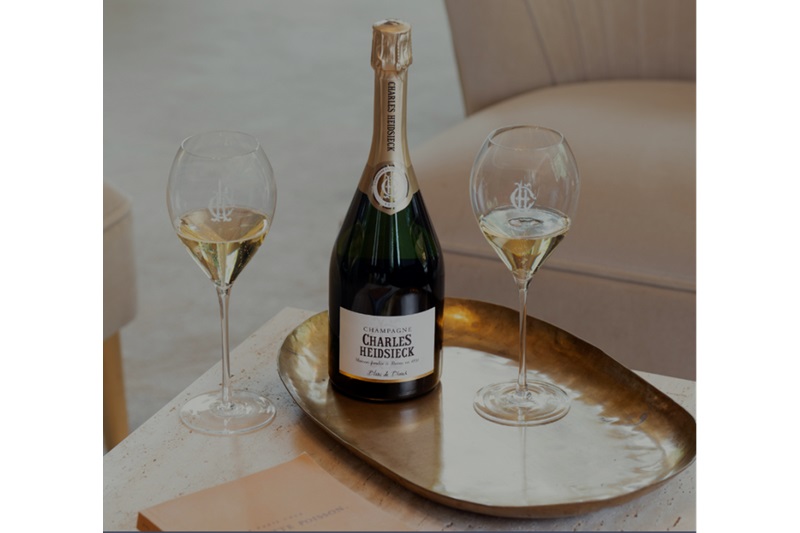Today, Champagne Charles Heidsieck is regarded as one of the finest Champagne houses, primarily due to the work of one man, Daniel Thibault. At age 29, Thibault became winemaker of Charles Heidsieck, owned by Champage Henriot at that time (where Thibault had been the winemaker). In 1981, Thibault began immediately making changes at Champagne Charles Heidsieck, which had been foundering in mediocrity. Thibault increased the percentage of older reserve wines to 40 percent in the non-vintage blend, calling it Brut Réserve, and aged it for five years before release. At that time, only the great Krug Grande Cuvée was setting such standards. He also improved Charles Heidsieck’s sister-house, Champagne Piper Heidsieck. However, to this day, the two Houses have different philosophies:
Piper-Heidsieck owns no vineyards of its own, sources grapes from 60 vineyards in the Champagne region, and produces between four to five million bottles of Champagne a year. It is the 8th largest-selling Champagne house, and its Champagne is available world-wide. Its average retail price in the U.S. is in the $34 to $39 range, a very good price for a reliable Champagne.
Champagne Charles Heidsieck produces only a half-million bottles of Champagne annually (about the same amount as the prestigious Champagne Krug), owns 132 acres of vineyards, and has long-term contracts with grape growers in the Champagne region. Champagne Charles Heidsieck is more difficult to find in the U.S.; its average retail price is now about $85 a bottle. It is full-bodied, crisp, and toasty, a Champagne to serve at dinner. Expensive, yes. But for me, it is the finest NV Brut Champagne produced among the major Champagne brands, other than the Krug Grande Cuvée, which retails for $160 today, at its lowest price. Charles Heidsieck also makes a prestige cuvée, Blanc des Millénaires; its current vintage is 2006. Charles Heidsieck’s Blanc Champagne is made only in small quantities, and retails for the quite steep price of $230. It is a quality Champagne, but other equally good, if not better, Blanc de Blancs Champagnes are available at lower prices.
I list here other Champagnes that I enjoy—without mentioning the numerous Grower Champagnes that I like, which I will save for a future column.
The two most well-known Champagnes, Moët & Chandon’s Dom Pérignon and Louis Roederer’s Cristal, are definitely worth the acclaim that they receive. Dom Pérignon, the most famous Champagne in the world, also has one of the largest annual productions (if not the largest) of all Champagnes. For me, this is what makes it truly great—to be made in the millions of bottles; this is just my estimate, as Moêt will not release its annual production figures. That it is so good in view of that production number is amazing to me. I mention here one example of Dom Pérignon that I tasted recently and love—its 2006 Rosé (about $300) is one of the best Rosé Champagnes that I have ever experienced—totally delicious, with a stupendously long finish: Dom’s 2006 white, also great, retails for about $170. Actually, Dom Pérignon’s 2008, from an incredible vintage, the best since 1996, is even better, and retails in the $160 to $170 range. If you are thinking long range, you can buy a 12-bottle case of 2008 Dom Pérignon for $1300, a great value, at Acker Merrill in New York.
Champagne Louis Roederer’s Cristal is considered by many critics to be the best Champagne produced today. It is exquisite, made from the finest grapes available, with an emphasis on the world’s best Chardonnay grapes. The aforementioned Acker Merrill sells the great 2008 Cristal for $180; its average retail price elsewhere is $250. Cristal’s current vintage, 2012, is selling for $50 to $60 more than the 2008. Buy the 2008! Incidentally, all of Champagne Louis Roederer’s Champagnes are excellent. Along with Krug, these are my two favorite Champagne houses.
Speaking of Krug, this amazing Champagne house produces my candidate for the world’s greatest Champagne—its Blanc de Blancs, Krug Clos du Mesnil. Krug ages this Champagne in its cellars for at least 10 years. Its current Clos du Mesnil, the 2006, retails for $1116, but the better 2002 Clos du Mesnil, still available for $1330, would be the one I recommend for an incredible tasting experience. If you don’t want to spend that much money on one bottle, seek out a friend who owns Clos du Mesnil!
Below is an alphabetical listing of 12 other Champagnes that I enjoy:
Champagne Billecart-Salmon, Cuvée Elizabeth Salmon Rose 2008 ($273)
Champagne Bollinger, Cuvée Vieilles Vigne Françaises 2010 ($1200) 100% Pinot Noir; bred from pre-phylloxera vines
Champagne Delamotte Blanc de Blancs 2008 ($110)
The sister winery of the very expensive Champagne Salon; very good value
Champagne Gosset “Célébris” Extra Brut 2002 or 2004 ($185/$190)
Champagne Jacquesson Cuvée 743 NV Extra Brut ($80); 2015 ($96) Best Value
Champagne Laurent-Perrier Cuvée Grand Siecle NV ($135/ $140), Good Value
Champagne Perrier-Jouêt Cuvée Belle Epoque, Blanc de Blancs 2002 ($300); Pennsylvania Control Board, 2006 $200 for residents— Blanc de Blancs is PJ’s best Champagne
Champagne Philipponnat, “Clos des Goisses” 2008 ($256; 2010, $212)
Champagne Piper-Heidsieck, Champagne “Rare” 2002 ($150/$155), Good Value
Champagne Pol Roger, Cuvée Sir Winston Churchill 2008 ($250/$270)
Champagne Ruinart, Dom Ruinart Blanc de Blancs 2002 ($175; 2004 or 2006, $182)
Champagne Taittinger, Comtes de Champagne Blanc de Blancs 2008 ($189)
The above are all great Champagnes, and my favorites. Happy New Year!

